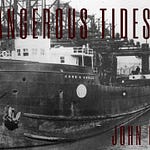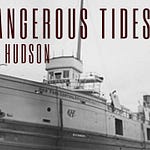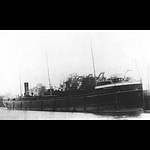This week on Dangerous Tides, we’re looking at a ship that had many a mystery surrounding its sinking, where no one was quite sure what had happened to have caused it, but is still worth studying, nevertheless. With only one survivor of the original 23 crewmembers that evening, the circumstances seemed near improbable to have sunk such a vessel on its second voyage. Her tragically short career proved that even the smallest of storms on the Great Lakes can sink a mighty freighter, and almost leave no survivors to tell the tale. So come aboard as we explore the SS Cyprus on Dangerous Tides.
The SS Cyprus started life in Lorain, Ohio, built by the Lackawanna Steamship Company, a newer subsidiary of Pickands Mather and Company, which today, is known as the Pickands Mather Group. Given the Panic of 1907, the frantic environment surrounding her creation was possibly a tell for the future. The American shipbuilding industry was bogged down with labor strikes. The backers of this new ship, along with her 7 other sisters, were eager to have a return on their investment. In an attempt to keep production moving, the company brought in new workers to speed up production. Despite these troubles, the Cyprus was a well-manned and properly equipped vessel, stretching out at 420 feet long with a weight of 15,000 short tons (or 14,000 tons). Her hull sported a 52-foot beam with a cargo hold that had a maximum capacity of 7500 tons. Among her equipment were two coal-fired Scotch boilers connected to a 1500 horsepower steam engine, which was quite a feat during a time when freighters were well-known to be underpowered. The Cyprus would launch on August 17th, 1907, and christened by Hazel Arnold, a daughter of a Pickands Mather executive. The Cyprus would neventually be based out of a small village northeast of Cleveland by the name of Fairport. One of the marine trade publications of the time described her as a very seaworthy vessel the day after her sinking.
The Captain of the Cyprus, Frank Brainard Huyck, (Hike) had 28 years of experience sailing, and spent 8 years on the Great Lakes. Only 4 years before, he was master of the Union Steamship Company’s passenger freighter, Chemung, until the American Association of Masters and Pilots started a strike. Union Steamship would break the strike, and many sailors, including Huyck, would be listed as agitators and blacklisted from working. By 1906, a friend and captain by the name of William Reed would present an opportunity for him to work as first mate for the Amasa Stone, also owned by another subsidiary of Pickands Mather and Company. Within a year, he would be given command of the Cyprus. Excited for his return to command, he considered it “a good ship“ and the Pickands Mather and Company “a first class company to work for.”
Many of the crew shared Captain Huyck’s excitement, including 17-year-old Nathan Lee Spencer, the eldest son of Port Colborne’s Postmaster, John Spencer, in Ontario. Though at first, he studied business and applied for the civil service exam to follow in his father’s footsteps, he quickly realized he wasn’t cut out for the job. He developed a fascination with machinery and engineering, seeking a position on a lake freighter. he was hired on as a fireman to stoke the Scotch boilers and hoped to get his younger brother a position in the company for the next season. He was the youngest member of the crew, consisting of 22 men and one woman, Olive Dundon, the wife of the steward, William, and second cook. With all the excitement onboard;, no one had anticipated this would be their last voyage.
On October 7, 1907, at 9am, the Cyprus would load 7,103 tons of iron ore in Superior, Wisconsin, approximately 400 tons short of full capacity. The weather was calm that morning, as they sailed for Buffalo, NY, for a seemingly routine voyage. The next morning, the weather would turn gloomy around 10 miles south of Stannard Light. A passing vessel, SS Charles O. Jenkins, would sight the Cyprus going downbound, but rolling heavily in moderate seas. It was enough to concern Captain Smith of the Jenkins, who was first to notice the listing. He kept watch of the ship, waiting for a distress flag to be raised, but the two ships passed each other with no incident, so, Captain Smith assumed they were holding their own.
The storm grew stronger as time passed, blowing over Lake Superior while it was still crowded with heavy ship traffic. Reports at the time would consider the storm not too challenging, especially for larger, well-equipped vessels such as the Cyprus. Another bulk freighter, the SS George Stephenson, would encounter the Cyprus at around noon, 18 miles off the coast of Deer Park, Michigan in the Soo Canal. Captain Harbottle of the Stephenson was towing a barge and sailing with a disabled boiler, but was managing through the storm without fail. They would spot a concerning red wake trailing behind the Cyprus, despite the freighter going twice the speed of the Stephenson. Still, the lights of the Cyprus sparkled on ahead, giving the sailors on the Stephenson some comfort that they would pull through.
Not long after the Stephenson sighted the SS Cyprus, Second Mate Charles Pitz would finish his watch and head to bed. When Charles would wake up for his next shift that evening, he found they were rolling in full gale and noticed a slight list to port. After reporting for duty, he inspected the cargo hold, finding that some of the iron ore had shifted and a small, but noticeable amount of water, was in the hold. When he went topside, he saw the ship‘s deck and hatch covers repeatedly submerged by the waves. The storm grew worse by 6:45 pm, causing concern among the rest of the crew, including Charles. Things quickly began to take a turn, with Captain Huyck realizing the severity of the situation. He ordered a watchman to gather all forward crew and send them aft to wear lifejackets and prepare the lifeboats. Huyck stopped short of giving the order to abandon ship, leaving him, Charles, First Mate John C. Smith, and Wheelsman George Thorne at the forward end while the rest of the crew was at the aft section, either maintaining steam or preparing to abandon the freighter.
Huyck fought to save the ship, but his primary concern was keeping the crew safe, tensely monitoring the situation, considering whether to keep fighting or send the crew off to battle the storm and reach land several miles away, an impossible decision to make… the Cyprus would soon make the decision for him at 7:30pm, as her portside plank sheared on the edge of the spar deck and the hull, submerging beneath the waves and creating a 20 degree list. Five minutes later, the fate of the Cyprus was sealed, when Chief Engineer James J. Norcross reported they lost steam pressure and the boilers went out. Turning to the other three men, the Captain told them “it’s all off, now.”
At 7:45, the men in the pilot house would race to unlatch the forward raft as the Cyprus capsized to port, tossing the men in the churning water. All four resurfaced and soon climbed on the raft. By the time they caught their breath, they watched the Cyprus sink in the storm. They heard the agonized screaming of the crew, but it was impossible to reach them as the forward crew fought to save themselves. They traveled an astonishing 18 miles, constantly being tossed by the sea as waves flipped the raft over and over again. The men were fortunate enough to swim back to the raft and resume their fight for survival. Just as they had sighted land at 2am, another heavy wave flipped the raft, sending the exhausted and freezing men into the water.
Charles resurfaced and mustered the last of his strength to swim back to the raft, finding himself alone. Only 3 feet from the shoreline, he paddled onward until he stumbled on the beach. Unable to stand, he crawled from the surf half a mile away from where the raft came ashore near the Deer Park Lifesaving Station, U.S. Lifesaving Surfman Ralph Ocha was on a routine patrol when he saw Charles barely clinging to life. The only word he could say was “Cyprus” as he was brought to the station. He figured if he was going to die, the Surfman would know which ship he came from. Charles survived 6 hours in the raft, with the bodies of the other 3 men recovered near where the raft came ashore, all having lost their lives only a few hundred feet from safety.
Nathan Lee Spencer was among the crew at the aft of the ship, likely maintaining steam until the end. Whether he and the rest of the crew made it to a lifeboat was unknown, but his body and all but two bodies of the ship’s crew were found. 22 people lost their lives, with Charles Pitz being the only survivor. As soon as he regained his strength, he told the tale of his harrowing experience, but as news spread of the ship’s loss, the question of what caused the Cyprus to sink remained.
To this day, the exact cause of the Cyprus’ sinking is still unknown, some speculating she had suffered a serious rudder or engine failure that reduced her ability to maneuver through the waves. Others suggested a flaw in the ship’s design or an undiscovered mistake made by untrained workers who built the bow during the labor strikes. No evidence for this theory would be revealed, as her 7 identical sister ships enjoyed long careers with no major disasters.
With no other explanation, attention turned to George Stephenson and Captain Harbottle‘s report of the red wake, which meant water was penetrating the hatches and mixing with the iron ore, only to be removed by the bilge pumps, creating the red color. The flooding caused her cargo to shift, creating the list that made her all the more vulnerable to capsizing. It was standard procedure to cover them with canvas tarpaulins to create a watertight seal, or “battening down the hatches”, it didn’t seem possible for an experienced captain like Frank Huyck to neglect securing the ship. Charles Pitz, in his statement to investigators, claimed the hatches were secured but no tarpaulins were used.
11 days after the disaster, Pitz would go on to serve as First Mate on the Maruba and returned to the Great Lakes to resume a decades long sailing career before passing away in his 70’s in 1961. In August 2007, The Great Lakes Shipwreck Historical Society made a discovery of the coast of Deer Park, Michigan. The sonar picked up the wreck of a long freighter 460 feet below the surface. After taking measurements, it was believed they had found the wreck of the D.M. Clemson, which had disappeared along the same spot on December 1, 1908. A week later, the team was able to send a remote-operated vehicle to examine the wreck. The first dive confirmed the wreck was indeed a freighter, but were not able to find the name. After conducting another dive later that day, which examined the ship’s stern, a name appeared on the camera view… Cyprus.
The wreck was assumed to lay 10 miles north of where she was found. The hull was intact, and offered important clue as to what sunk her. Components of the hatches were still found intact, confirm a theory that the Cyprus was fitted with new telescoping hatch covers, patented in 1904, which was initially believed to be watertight. This assumption proved dangerous on other ships with captains reporting these hatch covers to be unmanageable. These ships were quickly and quietly outfitted with canvas tarpaulins as essential equipment, with the ships owned by the Cyprus’ company being no exception.
Other details of that final voyage emerged from the family of Captain Huyck. On the first leg of the voyage, Captain Huyck had brought his wife, Helen, and his two sons, Ansel, aged 16, and Franklin, aged 12, to join him on his command. It was initially believed the entire family was lost, however they left before their final leg, to visit family in St. Paul, Minnesota. Before leaving the ship, Franklin recalled a conversation he overheard between his father and First Mate John Smith on a routine inspection of the hatches. He clearly remembered his father griping in frustration, “I’ll never make another trip without tarps.”
Still, the question remains. Why was the Cyprus permitted to disembark without tarps? Who made that decision? With everyone involved long since passed, we may never know what caused the mistake that cost 22 people their lives and resulted in the loss of the brand new freighter. Now, the Cyprus serves as a reminder of the wrath of Superior, and the trust that sailors need to place in their ships. One small omission, especially before OSHA and modern safety equipment, could prove the end of sailors’ lives before they start.
Thank you for joining us today. This episode is dedicated to the memory of all 22 crew members who lost their lives that evening near the shores of Deer Park, Michigan, as well as the efforts of the divers, historians, and maritime experts to make these episodes happen. May fair winds guide on Dangerous Tides.
Sources:
https://www.nbcnews.com/id/wbna20679934
https://www.usdeadlyevents.com/1907-oct-11-freighter-cyprus-sinks-lake-superior-storm-19m-off-deer-park-mi-21-22/
https://www.boatnerd.com/pictures/historic/Cyprus/default.htm












Share this post